Past events that had a major impact on the values of environmental radioactivity concentration and radiation are explained here.
Atmospheric Nuclear Tests (Mid-1940s to 1980)
They refer to nuclear explosion tests in the atmosphere (mainly in the stratosphere in the northern hemisphere) conducted by some countries such as the USA, Soviet Union, and China. Atmospheric nuclear tests started in the mid-1940s and became highly active from the late 1950s over to the early 1960s.
Radioactive materials generated by these nuclear tests spread throughout the northern hemisphere, and continued to fall onto the ground along with rainfall. These are called radioactive fallouts.The last atmospheric nuclear test was conducted by China in 1980. Since then, the radioactive materials near the ground surface have been gradually reducing.
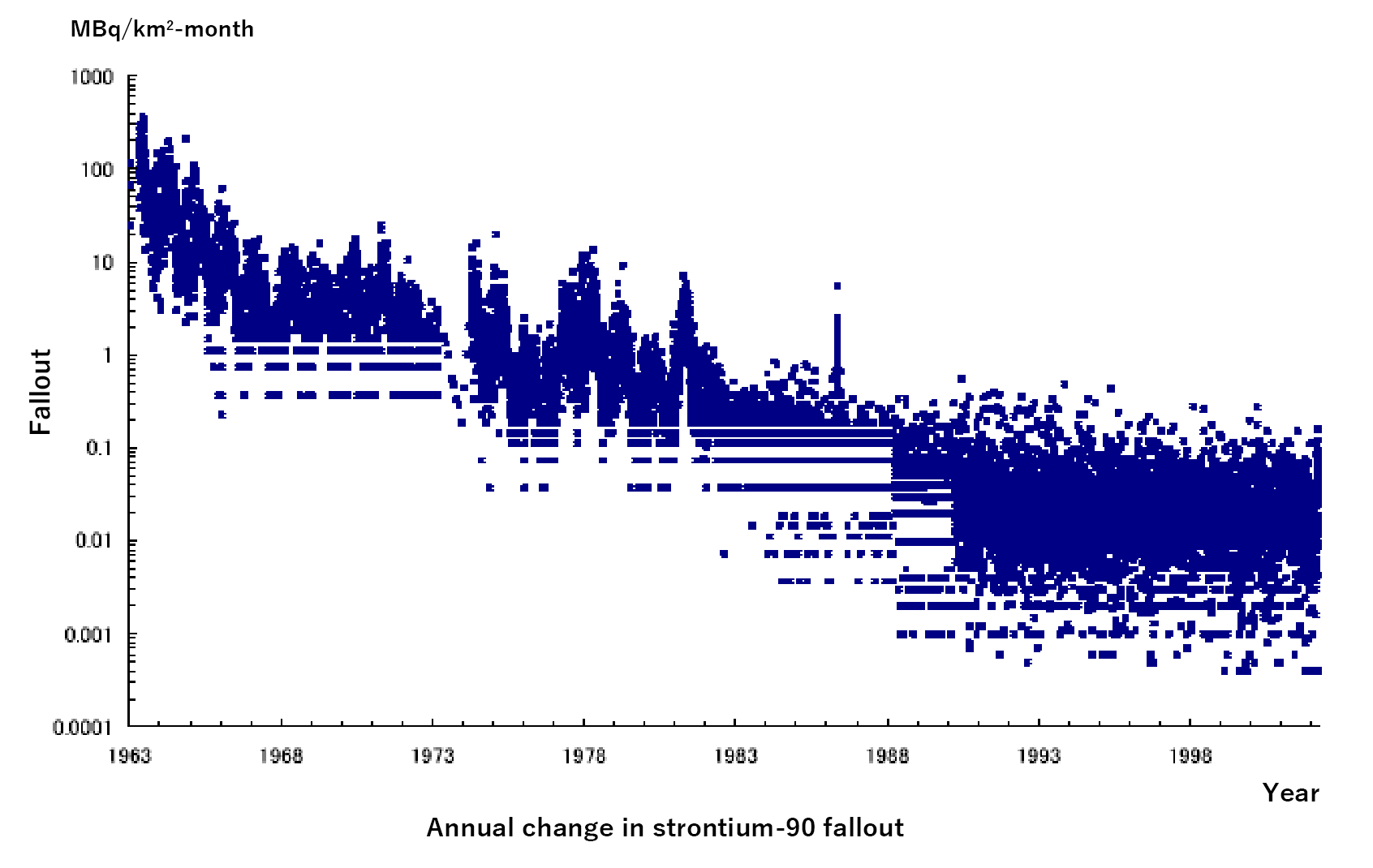
Annual fission and fusion yields of nuclear tests and atmospheric partitioning, all countries
| Year | Number of tests | Yield (Mt) | Partitioned fission yield (Mt) | ||||
|---|---|---|---|---|---|---|---|
| Nuclear fission | Nuclear fusion | Total | Local and regional | Troposphere | Stratosphere | ||
| 1945 | 3(*a) | 0.057 | 0 | 0.057 | 0.011 | 0.046 | 0 |
| 1946 | 2 | 0.042 | 0 | 0.042 | 0.011 | 0.031 | 0 |
| 1947 | |||||||
| 1948 | 3 | 0.10 | 0 | 0.10 | 0.053 | 0.051 | 0 |
| 1949 | 1 | 0.022 | 0 | 0.022 | 0.011 | 0.011 | 0 |
| 1950 | |||||||
| 1951 | 18 | 0.51 | 0.08 | 0.59 | 0.18 | 0.32 | 0.014 |
| 1952 | 11 | 6.08 | 4.95 | 11.0 | 2.89 | 0.28 | 2.91 |
| 1953 | 18 | 0.35 | 0.36 | 0.71 | 0.099 | 0.24 | 0.013 |
| 1954 | 16 | 30.9 | 17.4 | 48.3 | 15.4 | 0.31 | 15.2 |
| 1955 | 20 | 1.18 | 0.88 | 2.06 | 0.10 | 0.22 | 0.86 |
| 1956 | 32 | 10.0 | 12.9 | 22.9 | 3.68 | 0.99 | 5.31 |
| 1957 | 46 | 5.25 | 4.37 | 9.64 | 0.14 | 1.61 | 3.50 |
| 1958 | 91 | 26.5 | 30.3 | 56.8 | 5.86 | 3.31 | 17.3 |
| 1959 | |||||||
| 1960 | 3 | 0.072 | 0 | 0.072 | 0.036 | 0.035 | 0.0009 |
| 1961 | 59 | 18.2 | 68.3 | 86.5 | 0.011 | 1.15 | 17.1 |
| 1962 | 118 | 71.8 | 98.5 | 170.4 | 0.052 | 5.77 | 66.0 |
| 1963 | |||||||
| 1964 | 1 | 0.02 | 0 | 0.02 | 0.010 | 0.010 | 0 |
| 1965 | 1 | 0.04 | 0 | 0.04 | 0 | 0.037 | 0.003 |
| 1966 | 8 | 0.94 | 0.20 | 1.14 | 0.28 | 0.41 | 0.25 |
| 1967 | 5 | 1.88 | 1.30 | 3.18 | 0.011 | 0.046 | 1.82 |
| 1968 | 6 | 4.16 | 3.44 | 7.60 | 0 | 0 | 4.16 |
| 1969 | 1 | 1.9 | 1.1 | 3 | 0 | 1.90 | |
| 1970 | 9 | 3.38 | 2.40 | 5.78 | 0 | 0.095 | 3.28 |
| 1971 | 6 | 0.84 | 0.62 | 1.46 | 0.01 | 0.057 | 0.77 |
| 1972 | 5 | 0.13 | 0 | 0.13 | 0 | 0.11 | 0.02 |
| 1973 | 6 | 1.42 | 1.1 | 2.52 | 0 | 0.021 | 1.40 |
| 1974 | 8 | 0.75 | 0.46 | 1.21 | 0 | 0.19 | 0.56 |
| 1975 | |||||||
| 1976 | 3 | 2.32 | 1.8 | 4.12 | 0.01 | 0.09 | 2.22 |
| 1977 | 1 | 0.02 | 0 | 0.02 | 0 | 0.02 | 0 |
| 1978 | 2 | 0.04 | 0 | 0.04 | 0.02 | 0.02 | 0 |
| 1979 | |||||||
| 1980 | 1 | 0.5 | 0.1 | 0.6 | 0 | 0.11 | 0.39 |
| Total | 543(*b) | 189 | 251 | 440 | 29 | 16 | 145 |
| Total worldwide dispersion | 160.5 | ||||||
| Total measured global deposition | 155(*c) | ||||||
(From UNSCEAR 2000 Report)
(*a) Includes two cases of military combat use in Japan.
(*b) Total includes additional 39 safety tests: 22 by the United States, 12 by the United Kingdom, and 5 by France.
(*c) Inferred from Sr-90 measurements. Since radioactive decay of 2%-3% occurred prior to deposition of Sr-90, the estimated dispersed amount (injection into atmosphere) would also be about 160 Mt.
Chernobyl Nuclear Power Plant Accident (1986)
It refers to a nuclear reactor explosion accident that occurred on April 26, 1986 at the Chernobyl Nuclear Power Plant Reactor No. 4, in the western region of the Ukrainian Soviet Socialist Republic.
This accident caused a large amount of radioactive materials to be released into the environment, and many workers and nearby residents were exposed to radiation. The radioactive materials released by this accident flew even to Japan.
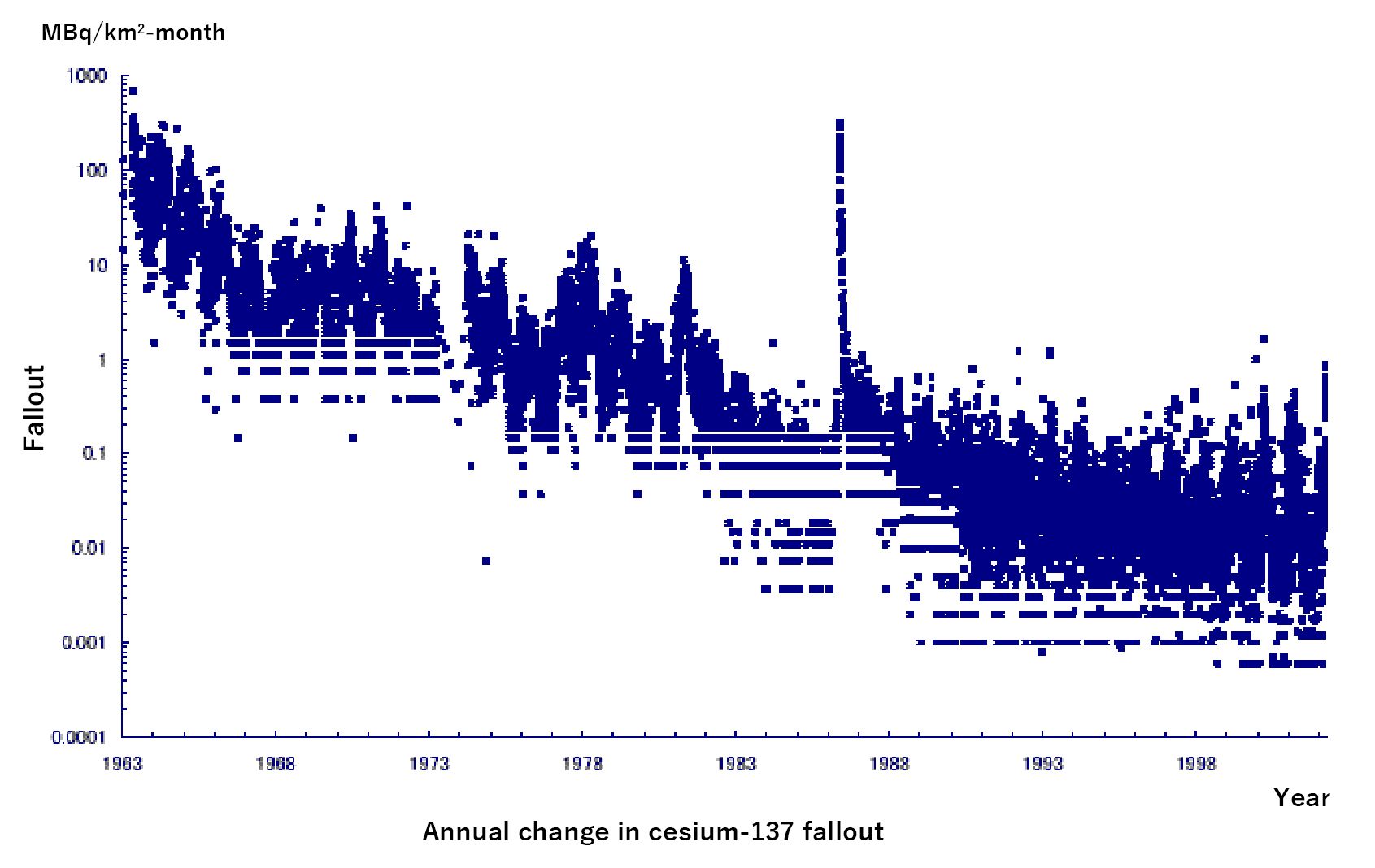
For several years after the accident at the Chernobyl Nuclear Power Plant, the results of Cs-137 radiochemical analysis may contain a small amount of Cs-134 originating from the accident.
(Reference) Estimates of main radionuclides released by the accident (×1015 Bq)
| Radionuclide | 1996 estimateb | Half-life |
|---|---|---|
| 134Cs | 44-48 | 2.06 years |
| 136Cs | 36 | 13.1 days |
| 137Cs | 74-85 | 30.04 years |
b: Decay adjusted to April 26, 1986
(From UNSCEAR 2000 Report, information on cesium was extracted)
JCO Criticality Accident (1999)
It refers to a criticality accident that occurred on September 30, 1999 at a uranium processing facility of JCO in Tokai, Ibaraki Prefecture.
This accident resulted in radiation exposure for three workers and the death of two workers. The air radiation level temporarily increased immediately after the accident.
Environmental Survey Pertaining to the Issue of Misuse of Depleted Uranium Ammunition
Office of Emergency Planning and Environmental Radioactivity, Ministry of Education, Culture, Sports, Science and Technology
In December 1995 and January 1996, during training at the Tori Shima Range (Fig. 1), aircraft of the U.S. Forces Japan accidentally used 1,520 depleted uranium rounds of ammunition (Fig. 2) whose use at training fields in Japan is prohibited by the rules of the U.S. Forces.
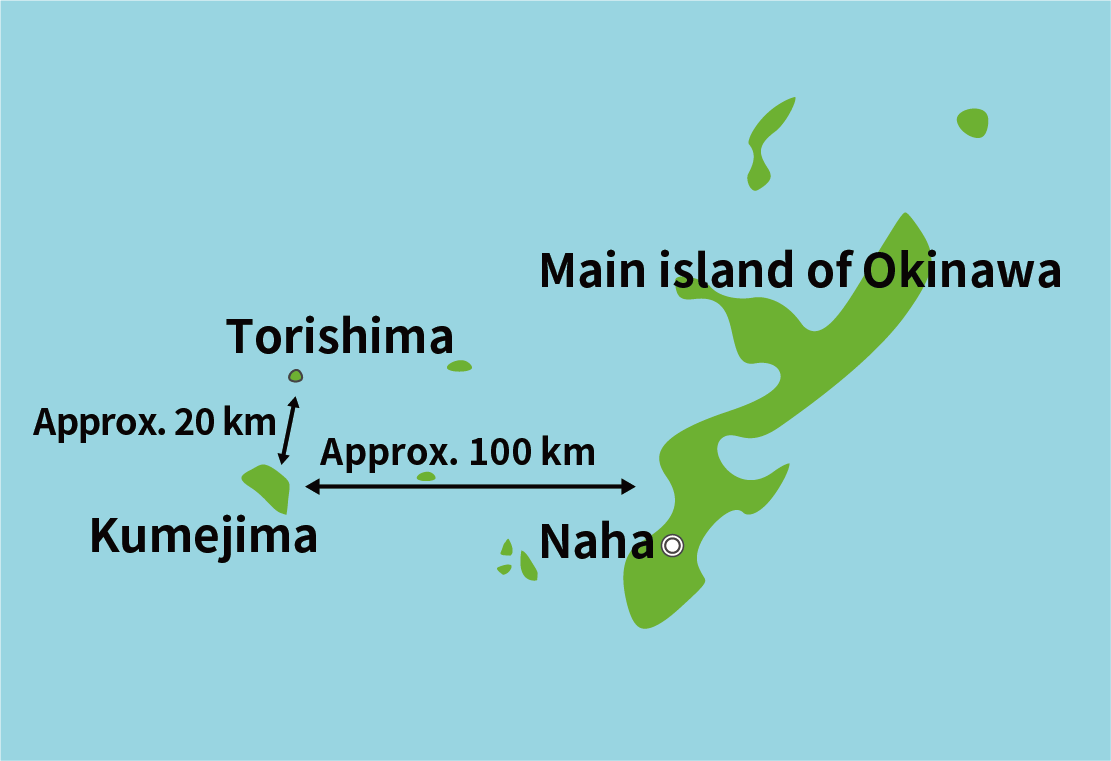
Fig. 1 Tori Shima Range
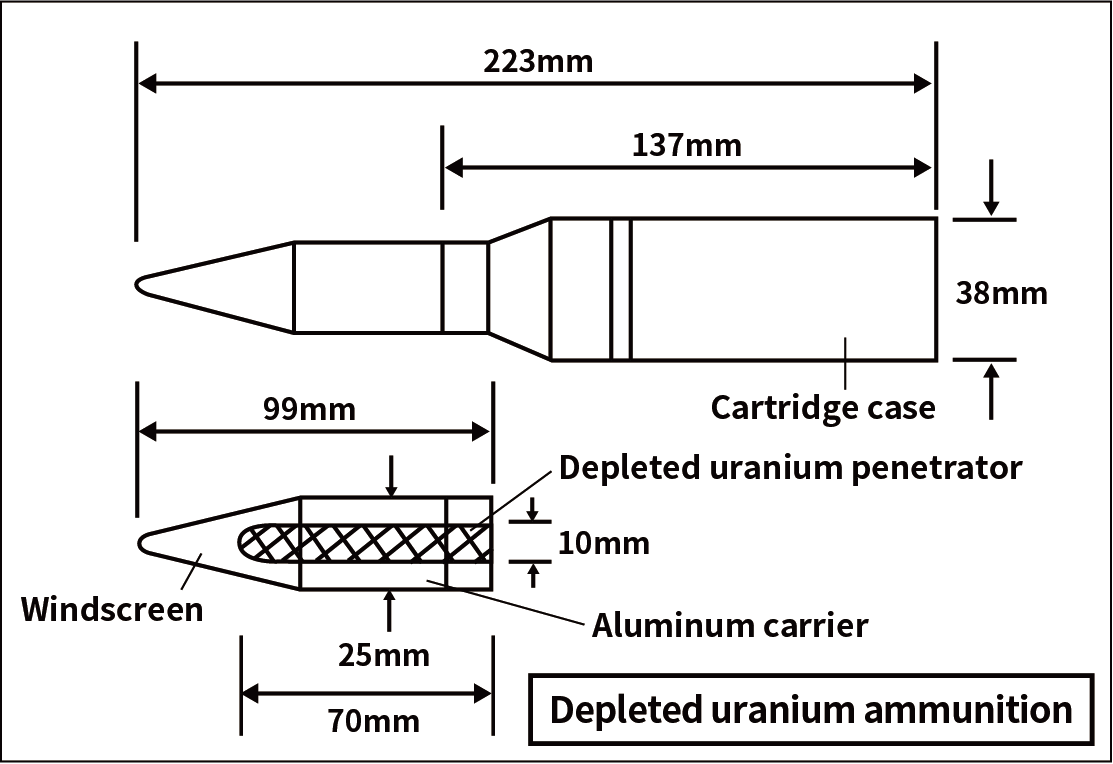
Fig. 2 Depleted uranium ammunition
In January 1997, on receipt of notification from the U.S. Government, the Japanese Government expressed its regret and requested the U.S. Government to prevent recurrence and to provide further information on this matter. In addition, the Japanese Government conducted environmental surveys from February to March 1997 and overall assessment (*1) of the situation.
Influence on Torishima
Surveys on the environment of Torishima verified no influence of depleted uranium on the air radiation dose rate, airborne dust, sea water and marine organisms (seaweeds) around Torishima.
Meanwhile, as for the soil, the surveys found no influence on flat areas, which account for the majority of Torishima, but depleted uranium was found in some of the soil at the southern slope of the northern hill of Torishima, which was allegedly used as a target for depleted uranium ammunition.
However, a study on their concentration found that the radiation dose contribution by external exposure to the depleted uranium is about 1/100 of that of natural uranium, and the effects of the radiation dose received from depleted uranium contained in such soil are adequately small.
From the above, taking into account the fact that safety management related to radiation is implemented at Torishima, the scope of effects of depleted uranium in Torishima is extremely limited, and its influence on persons setting foot on Torishima is considered to be adequately small.Influence on Surroundings of Torishima
Surveys on the sea area around Torishima verified no influence of depleted uranium on the air radiation dose rate, underwater radiation dose rate, sea water and marine organisms (fish, etc.) in the sea area.
Even if all of the unrecovered depleted uranium has been dissolved into sea water inside the restricted access area (about 5.5 km in radius) around Torishima, calculations suggest that the amount of the dissolved uranium is about 0.13% of the amount of naturally occurring uranium dissolved in sea water, and is not at a level to have any major impact. In addition, the Kuroshio Current constantly flows in this sea area, and depleted uranium is considered to be immediately diluted to the level of naturally occurring uranium dissolved in sea water. Therefore, the influence of depleted uranium on the sea area around Torishima is negligible.
As a side note, even on Kumejima, an inhabited area closest to Torishima, surveys confirmed no influence of depleted uranium on the air radiation dose rate, airborne dust, sea water and marine organisms (seaweeds) around the island. From this, depleted uranium is considered not to have any impact on the environment of Kumejima or public health.
Even if all of the unrecovered depleted uranium has become aerosols, calculations suggest that the radiation dose by inhaling such aerosols is about 0.3% of the radiation dose we normally receive from nature. Considering that it is impractical for the depleted uranium to have become aerosols in large quantities, the effects of depleted uranium that have become aerosols are negligible.
Summarizing the study results and considerations above, the influence of depleted uranium on the surroundings of Torishima is considered negligible.
The overall assessment is outlined below.
The toxicity of depleted uranium is the same as or less than uranium that exists in sea water or soil and sand around us.
The toxicity of depleted uranium is divided into the toxicity as a heavy metal and the influence of radiation. Of which, the toxicity as a heavy metal is exactly the same as uranium that already exists in the natural environment (so-called natural uranium). Regarding the contribution of radiation dose due to external exposure, since depleted uranium emits gamma rays and does not contain daughter nuclides that greatly contribute to exposure doses, its contribution is very small, about 1/100 of natural uranium.
Depleted uranium
It refers to uranium left after production of enriched uranium (uranium with the concentration of uranium-235 that releases nuclear reaction energy increased to about 3%) which is used as nuclear fuel at nuclear power plants. In depleted uranium, the concentration of uranium-235 is 0.3%, smaller than its concentration of 0.7% in natural uranium, and nearly 100% is uranium-238.
Depleted uranium ammunition
Ammunition that has a high penetration force utilizing the high specific gravity of uranium (19 times the specific gravity of water). It does not use the energy of a nuclear reaction, and therefore it is not a nuclear weapon.
Natural uranium is present around us in areas such as sea water and sands, and has been with us since the creation of the Earth.
About 70% of natural radiation we receive in our daily life comes from natural uranium, thorium, and their granddaughter nuclides.Natural uranium
A radioactive element with the atomic number of 92. It’s the heaviest among the 92 elements that occur naturally. It is contained in normal sands and sea water, albeit in small amounts. [Explanation 5]
Uranium-235 makes up 0.7% of natural uranium. The remaining 99+% is uranium-238.Toxicity of natural uranium and depleted uranium
Regarding the heavy metal toxicity of uranium, if a certain amount of uranium is ingested in a water-soluble form such as uranyl nitrate, it may have some impact on the kidneys or liver, similar to other heavy metals such as lead. However, as shown in [Explanation 3], depleted uranium in question is at a negligible level even if all of them were released into the environment. In addition, even if it is ingested, it is insoluble to water and swiftly released out of the body. Therefore, depleted uranium in this misuse issue does not pose a health concern.
Regarding external exposure among radiological impact, depleted uranium is free of daughter nuclides of uranium, and therefore the gamma-ray level is much lower than, about 1/100 of, that of natural uranium that contains daughter nuclides. As for internal exposure, since it is insoluble to water as stated above, it is swiftly released out of the body. Inhalation intake of depleted uranium may cause internal exposure to alpha rays, but for this misuse issue, the environmental impact is at a negligible level as shown in [Explanation 3], and will not cause any health issues.Wartime use of depleted uranium ammunition by the U.S. Forces overseas
Some reports health concerns of residents near sites where the U.S. Forces used a lot of depleted uranium ammunition overseas during a war. Of which, depleted uranium ammunition (approximately 10 tons as the amount of depleted uranium) were used in the Balkan Wars, but the United Nations Environment Programme (UNEP) conducted a survey in 2001 and reported that no region was at a level that requires a warning in its report Depleted Uranium in Serbia and Montenegro. Concerns over health issues in other regions warrant scientific evaluations in the future. At any rate, the amount of misuse in this issue was 190 kg, which is not very large, and there is no major environmental impact as stated in [Explanation 3] and [Explanation 5].
Assessment of environmental impact found no concerns compared with the concentration of natural uranium in sea water or natural radiation around us.
Even if all of the depleted uranium was released from the uncollected depleted uranium ammunition, its concentration and radiation dose are much smaller than the concentration of natural uranium that exists in sea water in the natural environment and the natural radiation around us (about 1/1000 of the concentration of natural uranium in sea water, and about 3/1000 of natural radiation). Therefore, it is assessed that the environmental impact of the depleted uranium ammunition is negligible.
Explanation 3 What is the assessment of impact on surroundings like?
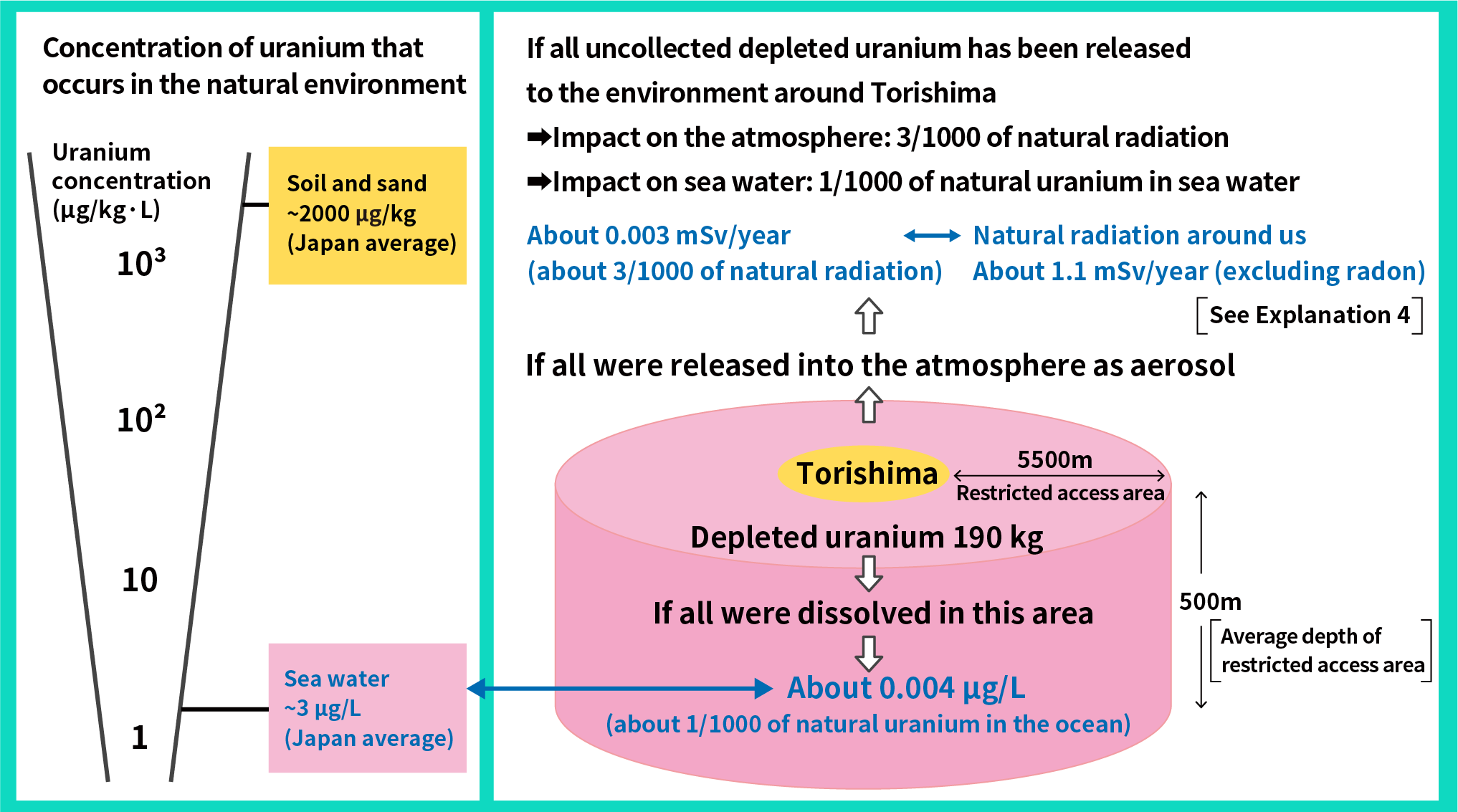
Explanation 4 What kinds of radiation are present around us?
Sources of radiation are present around us in nature. Though we cannot see or feel it, our bodies are always receiving radiation from nature. The amount of radiation we receive is about 2.1 mSv per year in Japan on average. The term “average” is used here, because the amount of radiation varies depending on the location. Even within Japan, the difference in the amount of radiation can go up to about 0.2 mSv per year. Outside Japan, in some places, the amount of natural radiation goes up to 10 mSv per year. The world average is 2.4 mSv per year. In addition to natural radiation, a Japanese person receives about 3.87 mSv per year on average for medical examinations and treatments.
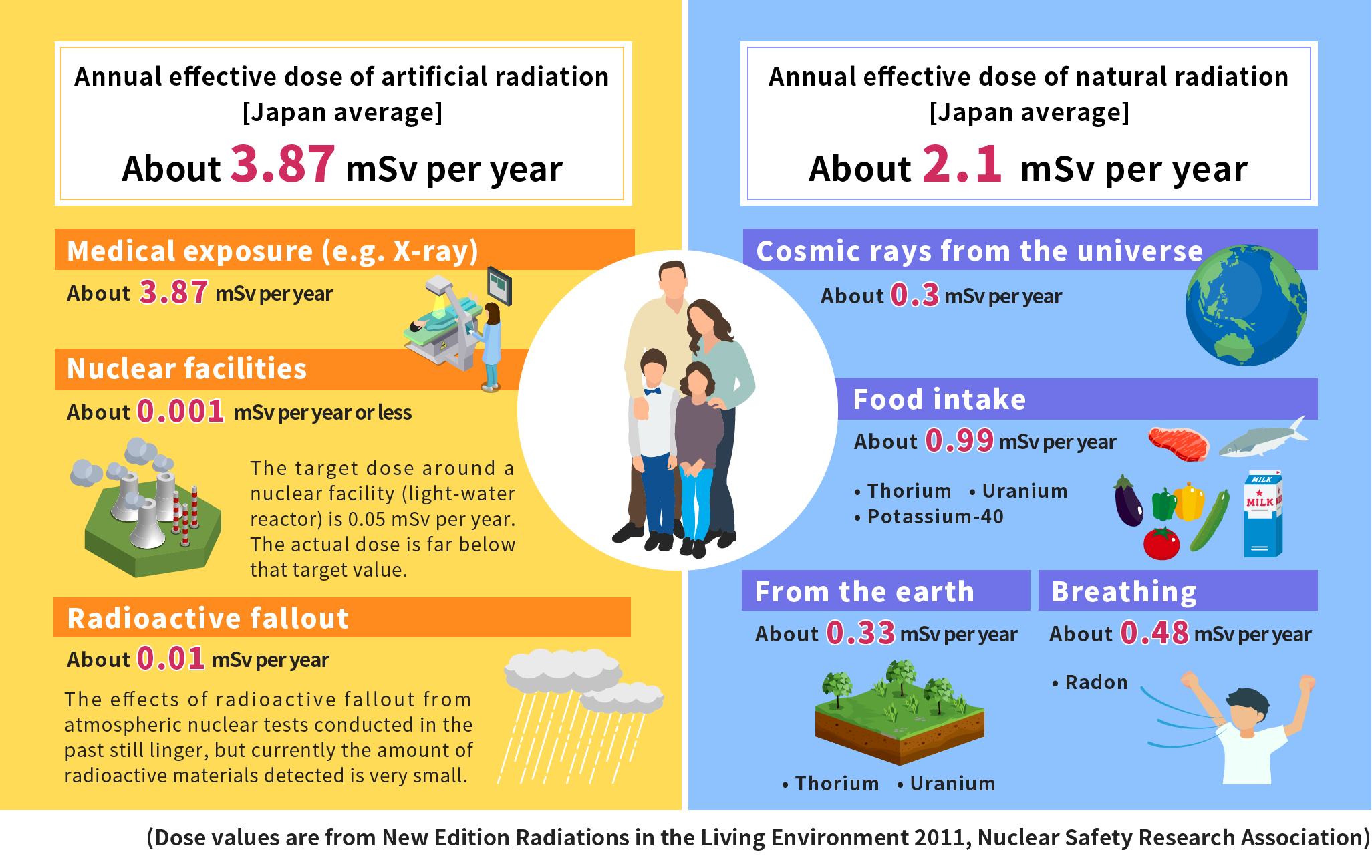
An environmental survey found no adverse effects of the depleted uranium.
An environmental radioactivity survey conducted also found no adverse effects of depleted uranium on the surroundings such as Kumejima, in support of the assessment above.
Explanation 5 What did the environmental survey at Kumejima find?
As an environmental survey, environmental samples such as soil and sea water were analyzed for uranium. The results were at a similar level as the results of natural uranium measurements performed in other areas (i.e. literature values), and the study on the uranium composition did not find any impact of the depleted uranium either.
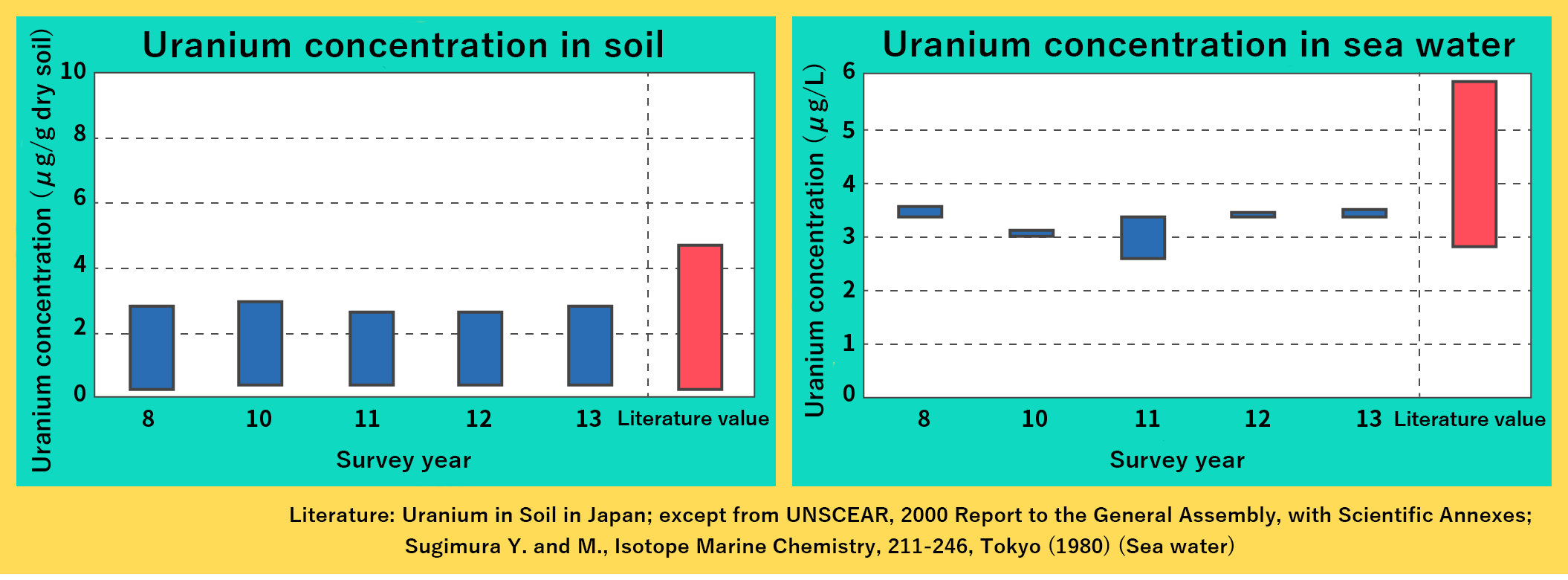
Surveys over 5 years also found no environmental impact of the depleted uranium.
Including the survey above, the results of the surveys conducted over a period of 5 years to 2002 found no environmental impact of the depleted uranium, again supporting the conclusion that the environmental impact of the depleted uranium is negligible.
Also, since year 2002 is a milestone year of the 5-year survey period, the toxicity of the depleted uranium was again scrutinized, which found no change from the conclusion of the overall assessment above.
